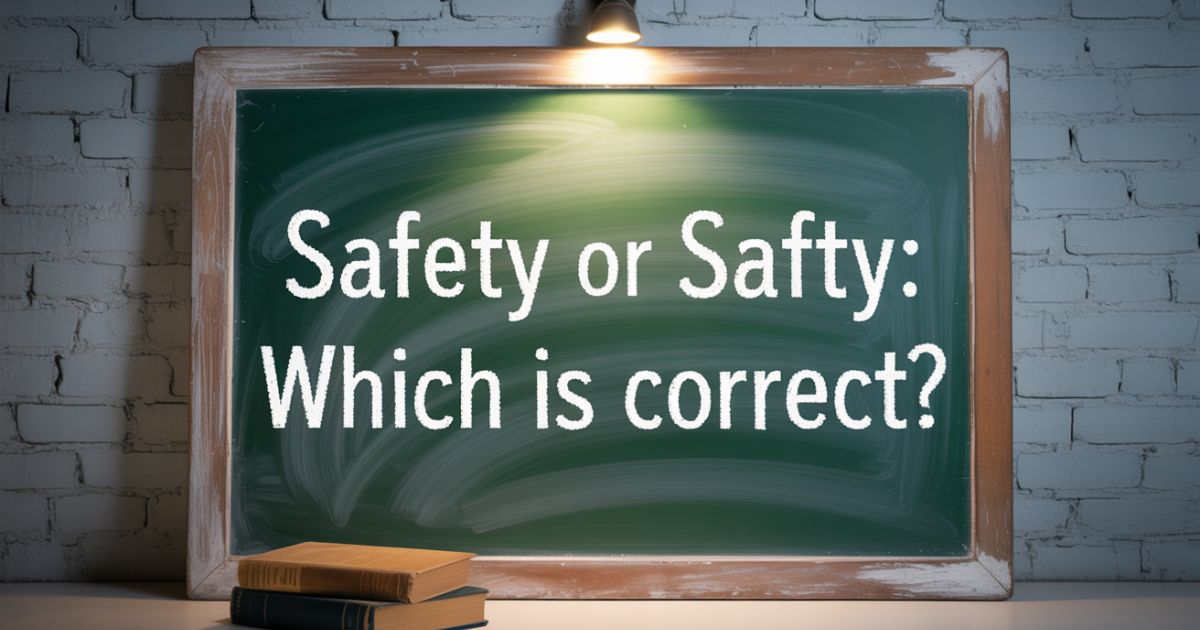The English language is full of confusing word pairs and common spelling mistakes that trip people up especially when the words sound similar. One such confusion is between “safety” and “safty.” You may have seen both floating around in different contexts on social media, in texts, or even printed on signs. But here’s the truth:
Only one of them is correct.
In this article, we’ll explore which version is right, why the confusion exists, and how you can remember the correct spelling. We’ll also look at real-life scenarios where this word is commonly used to help reinforce the concept.
What Is the Correct Spelling?
Let’s get straight to the point:
✅ The correct spelling is “safety.”
❌ The word “safty” is incorrect and considered a misspelling.
What Does “Safety” Mean?
Safety refers to the condition of being protected from harm, danger, or risk. It’s a word we use daily, from talking about wearing seatbelts to managing workplace hazards.
For example:
- “Wearing a helmet is important for your safety when riding a bicycle.”
- “The school has implemented new safety measures after the incident.”
On the other hand, “safty” has no meaning in standard English and will be flagged by spell checkers in any writing software.
Why Do People Confuse Safety and Safty?
There are a few reasons this confusion occurs:
1. Pronunciation Similarity
In fast or casual speech, people often drop the “e” sound in “safety,” making it sound closer to “safty.” For example, “safety first” might come out sounding like “safty first” when someone is speaking quickly.
2. Spelling Simplification
English is full of silent letters and irregular spellings. So, it’s common for learners or even native speakers to guess at the spelling based on pronunciation, especially when writing quickly or informally.
3. Autocorrect Errors
Sometimes, mobile keyboards or speech-to-text apps might misinterpret “safety” and change it to “safty,” especially if you’re using a custom dictionary or slang-heavy keyboard settings.
Real-Life Scenario Examples
Let’s look at a few situations where “safety” is the appropriate (and only correct) word.
Scenario 1: At the Workplace
Correct Usage:
“The factory manager held a meeting to review safety protocols and ensure everyone knew how to handle the new machinery.”
Incorrect Usage:
“The factory manager held a meeting to review safty protocols…” ❌
Imagine reading that on a safety sign. It would immediately cast doubt on the professionalism of the company.
Scenario 2: In a School Environment
Correct Usage:
“Parents are concerned about the safety of their children during school trips.”
Incorrect Usage:
“Parents are concerned about the safty of their children…” ❌
It may seem minor, but spelling mistakes in such contexts can cause misunderstanding or reduce the credibility of the communication.
Scenario 3: While Driving
Correct Usage:
“The car’s safety features include automatic braking and lane assist.”
Incorrect Usage:
“The car’s safty features include…” ❌
You’d expect official documentation or marketing material to get this word right. If it doesn’t, it can look unprofessional.
Common Phrases That Use “Safety”
Here are some frequently used expressions where “safety” is the only acceptable word:
- Safety first
- Public safety
- Safety guidelines
- Safety net
- Safety measures
- Safety precautions
- Workplace safety
You won’t ever see these phrases correctly written with “safty.”
How to Remember the Correct Spelling
Here are a few tips to make sure you never confuse “safety” and “safty” again:
1. Think of the Word “Safe”
The word “safety” comes from the adjective “safe.” Just like you wouldn’t spell “safe” as “saf,” you shouldn’t write “safety” as “safty.”
Safe ➡️ Safety
Not: Saf ➡️ Safty
2. Use a Mnemonic
Create a mental trick like:
“Safety has an E for Emergency preparedness.“
That small “e” can help you recall the correct form of the word.
3. Visual Memory
Picture a safety sign—most are printed with the correct spelling. Over time, repeated exposure helps reinforce the correct version in your mind.
Why Using the Right Spelling Matters
You might wonder, “Does a single letter really matter?”
Yes—it absolutely does, especially in professional, academic, or public writing. Here’s why:
- Clarity: Misspellings can distract from your message.
- Credibility: Errors make your writing look careless or unprofessional.
- Communication: In critical contexts (like legal, medical, or technical fields), the correct term ensures there’s no confusion.
Whether you’re writing an email, preparing a safety manual, or giving a presentation, spelling this word correctly shows attention to detail.
Conclusion
To wrap it up:
✅ “Safety” is the correct spelling, meaning protection from harm or danger.
❌ “Safty” is a common misspelling and should be avoided.
Whether you’re texting a friend or drafting a company policy, using the correct form ensures your message is taken seriously. So next time you type the word, pause for a second and double-check that “E” because when it comes to spelling, just like in life, safety comes first.


